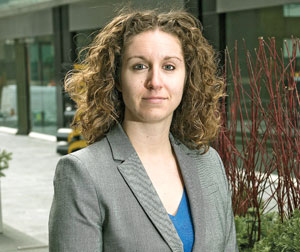The Ontario Court of Appeal has upheld a decision barring a Toronto firm from representing an insurance company in a coverage dispute because of a potential conflict of interest, despite the fact that the firm followed all ethical guidelines.

In
Ontario v. Chartis Insurance Company of Canada, the court found Douglas McInnis, of Lloyd Burns McInnis LLP, cannot represent AIG Insurance in a dispute with the provincial government as one of the firm’s lawyers, Michael Foulds, previously worked on the other side of the action.
Gavin and Brooke MacKenzie, a father-daughter duo that represented the appellants, say the decision injects uncertainty into the practice of law firms, as firms cannot be assured that erecting an ethical screen will be enough to protect them from disqualification.
“What the court said in this
Chartis case in effect was that where two lawyers on opposite sides of an ethical screen have a close working relationship on other unrelated matters, that increases the likelihood of inadvertent disclosure of confidential information and that, in those circumstances, compliance with law society guidelines and putting up an ethical screen in a timely way won’t necessarily be regarded as sufficient,” says Gavin MacKenzie.
Before joining Lloyd Burns McInnis, Foulds worked for Theall Group LLP and was involved in representing Ontario in the dispute. Since he moved to Lloyd Burns McInnis, Foulds has worked closely with McInnis, but he has not worked on the matter. Foulds has, however, worked on other files for the company and spends 50 to 60 per cent of his time working with McInnis.
The firm put an ethical screen in place, and the company filed a motion asking for a declaration that the screen was enough to prevent disclosure.
The safeguards the firm put in place included that Foulds would not discuss any Ontario-AIG matters with anyone at the firm, and he would even have a work space several offices away from those working on the matter.
“While technology, such as e-mail, might serve to diminish face-to-face interaction, the potential for inadvertent disclosure is significant,” said Court of Appeal Justice Sarah Pepall in the decision.
“Indeed, LBM recognized the potential for such disclosure by imposing a safeguard that Foulds’ office would be located several offices away from those LBM personnel working on Ontario-AIG matters. However, this precaution does little to address Foulds’ actual working relationship with McInnis.”
The provincial government brought a cross motion seeking an order that Lloyd Burns McInnis be blocked from representing AIG, arguing that not every conflict of interest can be met by following law society guidelines. The application judge sided with AIG, but the Divisional Court then overturned that decision.
The Court of Appeal found that the possibility that confidential information could be disclosed trumped the fact that the firm had followed all Law Society of Upper Canada guidelines concerning conflicts of interest.
There was no suggestion that any impropriety had taken place on Foulds’ part, but the court found that the firm’s compliance with the guidelines was not enough to rebut the presumption that confidential information could be inadvertently disclosed.
In 1990, the Supreme Court of Canada set out the requirements for removal in
MacDonald Estate v. Martin and invited law societies and the Canadian Bar Association to come up with guidelines concerning conflicts of interests.
But the law society’s commentary on the Rules of Professional Conduct acknowledge that following the guidelines that were developed may not be adequate in every case to prevent disqualification.
Gavin MacKenzie says this is the first decision since
MacDonald Estate in which a Canadian court has disqualified a law firm from acting on a case despite having set up a comprehensive ethical screen in a timely manner.
As Foulds and McInnes worked together at least 50 per cent of the time, the decision raises the question of what the threshold is for how closely two lawyers can work together without being at risk of disqualification, says Gavin MacKenzie.
Brooke MacKenzie says firms need to take note of the potential implications of the decision.
“Because even for large firms that have smaller practice groups or lawyers with regular communication with each other or a working relationship on multiple files, existing and future screens might not hold up to judicial scrutiny on a disqualification motion, if screened lawyers have a continuing working relationship with lawyers on the other side of the wall, because we don’t exactly know what that threshold of an extensive working relationship is such that the wall may be insufficient,” she says.
A spokeswoman for the Ministry of the Attorney General said the decision is consistent with the government’s position before the court ruled, but she declined to comment further, as it’s still within the appeal period.

 In Ontario v. Chartis Insurance Company of Canada, the court found Douglas McInnis, of Lloyd Burns McInnis LLP, cannot represent AIG Insurance in a dispute with the provincial government as one of the firm’s lawyers, Michael Foulds, previously worked on the other side of the action.
In Ontario v. Chartis Insurance Company of Canada, the court found Douglas McInnis, of Lloyd Burns McInnis LLP, cannot represent AIG Insurance in a dispute with the provincial government as one of the firm’s lawyers, Michael Foulds, previously worked on the other side of the action.